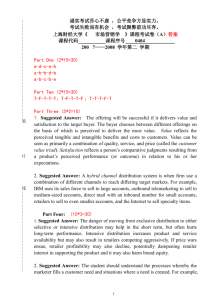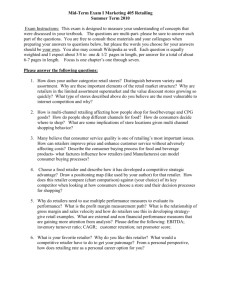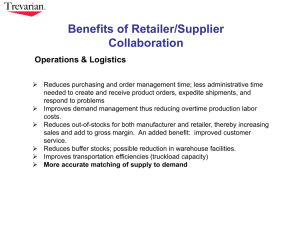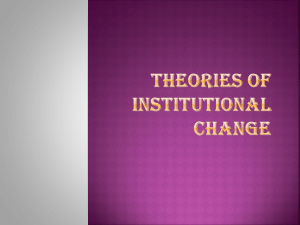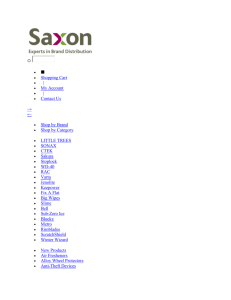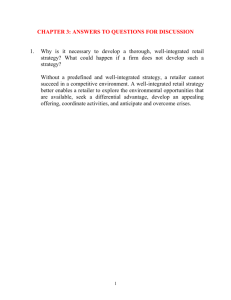Drawing Evolutionary Business Models for the Mobile Music Industry
advertisement
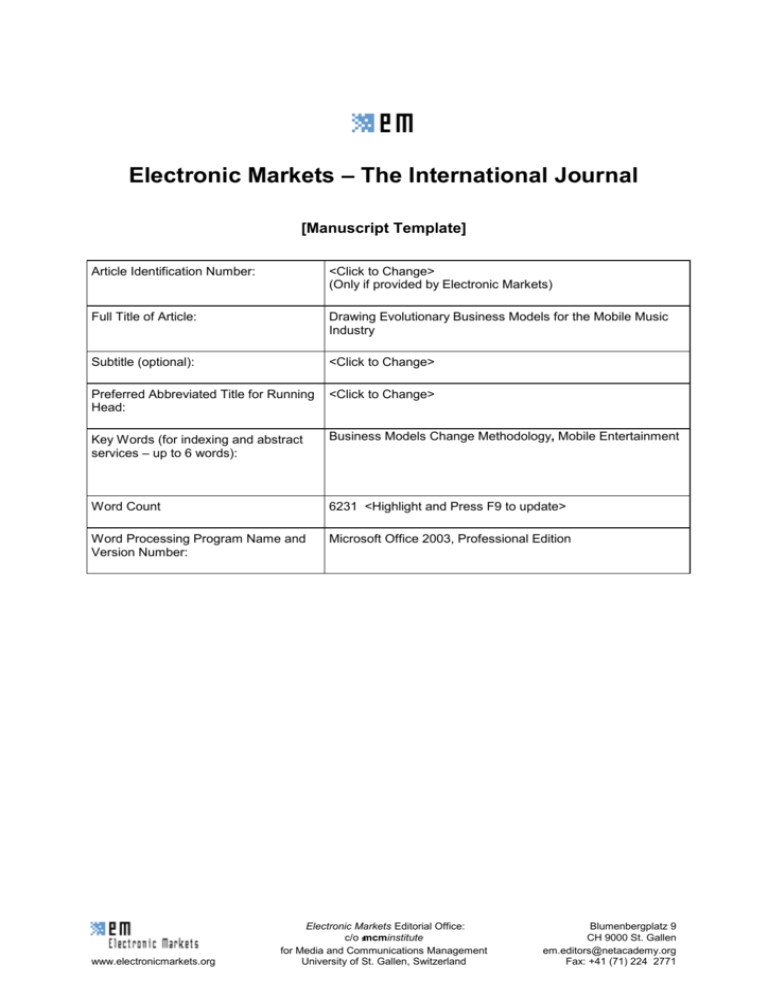
Electronic Markets – The International Journal
[Manuscript Template]
Article Identification Number:
<Click to Change>
(Only if provided by Electronic Markets)
Full Title of Article:
Drawing Evolutionary Business Models for the Mobile Music
Industry
Subtitle (optional):
<Click to Change>
Preferred Abbreviated Title for Running
Head:
<Click to Change>
Key Words (for indexing and abstract
services – up to 6 words):
Business Models Change Methodology, Mobile Entertainment
Word Count
6231 <Highlight and Press F9 to update>
Word Processing Program Name and
Version Number:
Microsoft Office 2003, Professional Edition
www.electronicmarkets.org
Electronic Markets Editorial Office:
c/o =mcminstitute
for Media and Communications Management
University of St. Gallen, Switzerland
Blumenbergplatz 9
CH 9000 St. Gallen
em.editors@netacademy.org
Fax: +41 (71) 224 2771
533577814, page 2/31
Drawing Evolutionary Business Models for the Mobile
Music Industry
Pavlos Vlachos, Adam Vrechopoulos, Adamantia Pateli
Athens University of Economics and Business,
76 Patission Str., GR10434, Athens, Greece
{pv, avrehop, pateli}@aueb.gr
Abstract (structured along the lines of: background, aim, method, results, conclusion – 150 –
200 words):
The plethora of actors, the complexity of relationships and the variety of information and financial flows
affecting the mobile entertainment arena today, have created a series of challenging business opportunities for
entrepreneurs and key market players. The evolving and quite promising mobile music market, however, is
suffering from the luck of integrated theoretical frameworks critical for the business activity acceleration and for
the corresponding mobile music services diffusion. In this paper, we advocate the application of a scenario based
business model change methodology for the purpose of transforming the current business models of the
traditional and online music industry to a new business model appropriate for the mobile music industry. To do
so, we are based on the results of a qualitative research study, which involved in-depth interviews with content
providers, mobile operators and music consumers using semi-structured questionnaires. To that end, the present
study applies the available business model theoretical insights to the music industry and depicts the current
business practice in terms of (i) the employed content delivery channels (i.e. traditional, Internet, mobile), (ii) the
participating actors and (iii) the relative flows. Key business modeling issues are discussed and direct managerial
implications to potential players are also provided. Finally, straightforward directions for further research are
discussed at the end.
533577814, page 3/31
The Evolving Nature of Mobile Entertainment Business
Mobile voice services in Europe and Asia are soon reaching saturation, and thus wireless operators
are forced to seek for new revenue sources (Durlacher 2001). Keiji Tachikawa, the president and chief
executive officer of NTT DoCoMo, Japan’s largest mobile operator, declares that: “Unless we are
able to cultivate and grow data traffic, we cannot guarantee further growth for the mobile
communications industry” (Economist 2003).
In their effort to differentiate their product/service portfolio, diminish their revenue dependence on
mobile voice services, and recoup the huge investments made on third generation networks, mobile
network operators, try to develop new services and evolve their current business practice. In parallel,
traditional music industry value chain is rapidly being re-engineered and many experts in the field
support that ‘business as usual’ in the music industry is over (Meisel and Sullivan 2002). Currently, a
wide range of companies including Mobile Network Operators, record labels, computer software and
hardware companies as well as dot-coms experiment on finding viable business models for delivering
music via electronic channels.
Online music ventures are continuously reshaping their value propositions due to competitive reasons,
rights management issues and evolving demands of the online music consumer. While the online
music industry is close to a solid business and revenue model configuration, the same is not true for
the mobile music industry. The fact is that research (both academic and business) on mobile
entertainment in general, and mobile music in more particular, just now starts to emerge (Maciness et
al., 2002).
The emerging mobile music market seems to be of great importance for both Mobile Network
Operators and music content providers. Mobile Network Operators strive to find new, voice
independent, revenue streams, while on the other hand music content providers try to find new ways
to distribute their music content securely and at a profit. As soon as a broadband, either mobile (3G)
533577814, page 4/31
or wireless (WLAN), network infrastructure is established and advanced mobile music devices are
delivered, a great set of music subscription services will be provided to the wireless music consumers.
We propose that the scope of the mobile music industry is to market digital music content (music
songs, video clips and music related content) over mobile data networks and devices with the
objective of offering rich entertainment experiences to consumers anytime and at any place. In a
typical mobile business model, we can find a Mobile Network Operator getting music content from a
traditional music retailer and music content platform from an application service provider (value
inbound flows), and paying commission fees (financial outbound flows) to the content and service
providers and the handset manufacturers.
In this paper, we discuss the application of a business model change methodology for the purpose of
transforming the current business models of the traditional and online music industry to a new
business model appropriate for the mobile music industry. To do so, we have been based on the
results of a qualitative research study, which involved in-depth interviews with content providers,
mobile operators and music consumers using semi-structured questionnaires. This qualitative research
enabled us to better understand the way in which the traditional and the online (fixed internet) music
industry business models operate, as well as capture requirements for the emerging mobile music
business model.
Specifying Evolutionary Modes of Business Models
Business Model was one of the great buzzwords of the Internet boom. As Joan Magretta (Magretta,
2002) contends: ‘A company didn’t need a strategy or a special competence or even any customers- all
it needed was a web-based business model that promised wild profits in some distant, ill- defined
future’. After the renowned dot.com crash, it was inevitable for the term “business model” to fall out
of fashion. But as Joan Magretta puts it: ‘…the fault lies not with the concept of the business model
but with its distortion and misuse. A good business model remains essential to every successful
organization’.
533577814, page 5/31
In order to describe and analyze a business model, several conceptual models and ontological
frameworks have been provided in the literature (Weil and Vitale, 2001; Osterwalder and Pigneur,
2002). Some of them emphasize the revenue model followed and the value raised for the customer
(e.g. Afuah and Tucci, 2000; Chesbrough and Rosenbloom, 2000), while some others focus on
analyzing the actors that participate in the model and their exchange flows (e.g. Gordijn and
Akkermans, 2001; Papakyriakopoulos et al., 2001). In this research, we adopt the view that a business
model is a ‘collection of a series of bilateral relationships between players of the same or different
industries, all participating in the creation of value’ (Rayport and Sviokla, 1995). The term ‘value’
includes the service flow and the communication flow (Barnes 2001). Thus, the main components
discussed in the business model analysis of the emerging mobile music industry include actors and
value (service, communication, revenue) flows.
Under the influence of technology trends, most importantly information and communication
technologies (ICT), many current organizational business models are being questioned, and
companies are faced with the challenge of business model change. However, creating a radically new
business model is a high-risk strategy, as the probability of getting it right is acknowledged to be low
(Kalakota & Robinson, 2001). Companies typically choose to focus on an improvement strategy that
is less risky and extends or renews their existing strategy and business model. The issue of business
models change is an emerging domain of research on business models (Pateli & Giaglis, 2004) with
intense interest for further investigation but only a few studies currently addressing it.
Amongst the few authors researching the area, Tapscott et al. (2000) have identified six steps for
changing a current business model to a b-web model. Naturally, the method proposed is customized to
the b-web concept and thus can hardly be thought of as a generally applicable change methodology.
Following a different approach, Linder and Cantrell (2000) provide a general framework that defines
a set of change models, classified based on the level of change introduced by the new business model:
realization, renewal, extension, and journey models. The identification of four types of change models
serves the organizations’ need for first identifying the level of change, and thus the change model,
533577814, page 6/31
they want to introduce, and then building the organizational machinery required for executing their
change model.
Petrovic et al. (2001) have made an attempt to introduce a generic business model change
methodology grounded on a well-established theoretical framework. However, the steps of their
methodology are described in quite general terms, and no guidelines or advice is provided for the core
part of the methodology, which is the actual implementation of change.
Finally, Papakiriakopoulos et al. (2001) propose a step-by-step methodology for transforming a
business model, responding to the need for changing the firm’s technology infrastructure. Again, the
utility is restricted in the sense that it applies only to technology-driven business model change, as
opposed to change driven by a new market or business opportunity. The analysis is also focused on
industry level (as opposed to firm level) change.
Although all these methodologies provide valid starting points for addressing business model change,
they all share a common drawback: they are quite monolithic, in the sense that they provide a strict
linear sequence of steps that an organization should follow when approaching business model change
as a result of a technology innovation. As such, these methods might be more appropriate in relatively
stable industry settings where a lower level of risk might be associated with business model change.
However, when considering more turbulent and complex contexts, such as the emerging market of
mobile and wireless communications that is dealt with in the case study discussed later in this paper,
such methods might not yield satisfactory results. In this paper, we advocate the use of a scenariobased methodology for approaching business model change. Using scenarios has been acknowledged
as standard management practice to support more flexible decision-making and less risky strategic
positioning against alternative ‘futures’ (Godet, 2001).
In the following section, we discuss the application of these methodology for drawing scenarios or
alternative business models for the commercialization of mobile music services.
533577814, page 7/31
Scenarios for Alternative Mobile Music Business Models
The methodology consists of three phases, which are further decomposed into six steps. In what
follows, we briefly discuss the primary mission and anticipated result of each phase and describe the
steps included in it.
Phase I: Business Model
The purpose of this study is to map a set of emerging mobile music business models. To do so, one
should first map and understand the predecessors of the mobile music business model, namely the
business models of the traditional and the online music industries.
Step I: Document the Current Business Model
For developing the business models of the traditional and online music industries, we employed a
qualitative research design along with an extensive literature review. In addition, we thoroughly
examined a set of available current business practices (case studies). More specifically, in-depth semistructured interviews with three key players of the music industry were conducted. Next, nineteen
interviews with executives from music content providers in Greece and UK were conducted. Music
content providers interviewed were major labels affiliates and local independent music labels. Finally,
twenty-five consumers in Greece and UK were interviewed. Potential mobile music consumers were
selected using a convenience sampling methodology, which is considered to be appropriate in
exploratory research settings as the present one. Figure 1 provides a graphical illustration of the
methodology employed for capturing information on the reference business models of the traditional
and the online music industries.
Insert Figure 1
533577814, page 8/31
The first step was to document the current business situation in order to define realistic business
requirements for the design of the mobile application and to outline the business environment in
which it will be introduced. This analysis included a detailed description of industry norms, types of
stakeholders involved, partnerships, revenue-sharing agreements, and so on. Due to space limitations,
only the analysis of roles is presented in Table 1.
Insert Table 1
According to Table 1, the key players in the traditional music industry are ten, while the Internet
music industry involves nine actors. The information and revenue flows between these actors in each
business model are illustrated in Figures 2, 3.
Insert Figure 2
Insert Figure 3
Phase II: Identify Technology’s Influence
Step 2: Asses the Influence of Technology Innovation
Following the specification of the two currently adopted business models for the delivery of music
content, this step aimed to identify those business model elements that are most liable to change due
to the introduction of the mobile network as alternative or advanced music delivery channel. Based on
theoretical investigations in the area of technology innovation but also a series of discussions with the
above presented music stakeholders, several effects of the mobile technology on the current way of
providing music services have been spotted and are briefly described in Table 2.
Insert Table 2
Step 3: Identify Missing Roles
533577814, page 9/31
The roles identified in step 1 have been found inadequate to supply the competencies required for the
delivery of music via a mobile channel. More specifically, the need for one or more new player(s)
accomplishing the following groups of activities has been identified:
a) Development and maintenance of the content storage and delivery platform. This activity
includes the tasks of development, implementation, configuration, and administration of the
mobile music platform, which is used to organise, store and manage music files.
b) Music content provision and syndication, management and delivery. Syndication refers to “selling
the same information to many different customers, packaging it with other offerings in uniquely
valuable ways, and then redistributing it” (Werbach, 2000). In this case, syndication concerns
creating personalised “music albums”, including audio and video clips that the music consumer
has downloaded to its handheld device, or dynamically personalising the music distributed to each
mobile user, giving the sense of providing a personalised “mobile radio program”.
c) Handset manufacturing and customization, including tasks for collecting requirements for
evolving the current mobile phones or the emerging smart phones, as well as designing new type
of handheld devices, that could be used as mobile music players of high quality.
d) Mobile network operation and maintenance for music delivery, including tasks for evolving the
current network installation with 3G features, so that the delivery of music content (audio, video,
and news) and services of high quality is assured.
Phase III: Change
Step 4: Define scenarios for alternative business model configurations
Some of the above responsibilities can be allocated between two or more actors of the traditional and
online music industries. For instance, the role of mobile platform development and maintenance can
be played by either an application provider of the online music industry or, less possibly, by a media
company, currently belonging to the traditional and online music industries. However, some
533577814, page 10/31
responsibilities demand for new players acquiring resources and skills that none of the current music
stakeholders possess. Table 3 lists the set of key roles in the mobile music industry.
Insert Table 3
The scenarios described hereinafter concern alternative allocation of the above responsibilities
between the actors of the traditional and online music industries as well as newly introduced players
belonging to the mobile industry. These scenarios have been defined and discussed through the
qualitative study, which was described in step 1. Analysis of the results indicated three possible
scenarios for further consideration.
a) The Direct Sell scenario. This scenario concerns the provision of a direct channel for delivery of
music from the branded music retailed to the mobile consumer (e.g. i-mode site). It involves a
loose ‘content – operator partnership agreement’ for the access to the music library of the branded
music retailer by the subscribers of the mobile network.
b) The Aggregator scenario. According to this scenario, the overall responsibility for both
technology infrastructure support and service provision and management belongs to the mobile
network operator, who usually acts as a portal aggregating a set of mobile entertainment services
(e.g. music, news, astrology, games, etc.). In this scenario, the agreement between the branded
music retailer and the mobile network operator requires higher commitment from the part of
mobile music retailer, since the brand name of the operator is under greater risk.
c) The Hybrid scenario. As it is inferred by its name, this scenario includes delivery of music
content and services though a dual channel; the MNO’s portal and the site developed by the
branded music retailer, wholesaler, record label or even the traditional media.
Step 5: Analyze the key elements of alternative business models
Each of the above scenarios can lead to the development of one or more alternative business models
by assigning real-world players to the scenario’s roles and discussing in detail issues regarding the
533577814, page 11/31
value proposition of each actor, the partnerships developed between them, the key resources
contributed by each and their revenue-sharing agreement. Hereinafter, due to space limitations for
analyzing a set of alternative business models implementing each scenario, the paper has focused on
formulating three general but representative business models, naming each one based on the scenario
that it implements.
The “Traditional Retailer” Mobile Music Business Model
In this case, the MNO (Mobile Network Operator) takes a less active role in handling mobile music
content. This means that the mobile music service offered by branded content retailers (e.g. a CD
retailer, a music channel) will be the one with which the music customer will interact. Obviously,
there can be many mobile music retailers’ sites in the mobile portal of the MNO, who will compete
for gaining mobile customers’ preference. These “retailers” will be responsible for crafting the
marketing mix of the music service offered to music customers, so as to be appealing to their
predefined music customer target group. Music customers will select their mobile music retailer based
on the offered marketing mix and most importantly based on perceived mobile music service quality
(Vlachos et al. 2003). These mobile music retailers will exploit the music content and the mobile
music platform offered from a service provider who will probably act as a content aggregator having
deals with several. Figure 4 maps an instance of the “Traditional Retailer” mobile music business
model.
Insert Figure 4
While the value flow diagram, depicted in Figure 4, is somewhat simple, that is not true for the
revenue flow diagram. We have hypothesized that consumers pay branded music retailers for the
music content they buy (through their monthly phone bill or in a ‘pay as you go’ way - i.e. the
reduction in the value of the prepaid mobile phone card). The fees of the MNO will probably stem
from: (a) the charges for the consumers’ usage of the mobile data network, and (b) a commission
based fee from the branded music retailer (Ratliff 2002). The fees for the music retailer come from
533577814, page 12/31
charges on the music services (subscription-based) as well as changes on the music items sold (item or
volume-based).
This specific business model includes also the case where records labels market their content directly
to music customers (i.e. “disintermediation” effect in e-commerce) (Turban and King 2002). This
strategic decision will be based upon two major factors: (a) the emerging channel conflict between the
record labels and traditional retailers, and (b) the mobile users’ requirements; whether they prefer the
one-stop-shop solution (provided by the MNO’s portal) or opt for buying their preferred music
content directly from their producers or retailers.
The “Mobile Network Operator Dominated” Mobile Music Business Model
In this case, mobile music services are solely offered by Mobile Network Operators (MNO). In other
words the MNO takes the role of the mobile music retailer – i.e. the brand. The MNO gets the music
content from a music content aggregator and offers it to its customers through an “own branded”
mobile music service. It is obvious that in this specific business model, the MNO takes a more active
role in handling the mobile music service. Therefore, the MNO will be responsible for crafting the
marketing strategy and the marketing mix of the offered mobile music service. Regarding the elements
of the marketing mix, this business model assumes that the MNO will have to define them. For
example, with regards to the product element of the mobile music service marketing mix, the MNO
will be the one that should decide on the brand name and logo of the mobile music service, the music
content depth and width, the user interface, e.t.c.
A strategic issue related to this model is whether the MNO will allow other branded mobile music
services to be offered through its mobile music portal (see the traditional retailer mobile music
business model). For drawing the business model instance, in Figure 5, it is assumed that the MNO
will not allow other branded mobile music services to be offered to its customer base.
Insert Figure 5
533577814, page 13/31
With regards to the revenue flow model, the service provider pays a fee to the content providers for
music content licenses, and the MNO pays fees to mobile music service provider for music content
aggregation services and for the mobile music platform. From the demand-side perspective,
consumers pay fees to the MNO for accessing the mobile music service and for using the mobile data
network.
The “Hybrid” Mobile Music Business Model
In this mobile music business model, the service provider offers its platform and content both to the
“branded music retailer” and to the MNO. In this business model scenario, the end-user can subscribe
(or choose the pay as you go payment scheme, if it is offered) both to the mobile music service
offered by the “traditional music retailer” and to the mobile music service marketed by the MNO.
Simply, in this scenario, the MNO decides to offer through his mobile portal also his own branded
mobile music shop (as is the case of ‘own label’ products in grocery retailing).
Insert Figure 6
Figure 6 depicts the case where consumer C1 has preferred to get his/her pure mobile music directly
from the Branded Music Retailers, while consumer Cn has chosen the mobile music service offered
from the MNO.
Step 6: Estimate the impact of technology innovation on the external environment
The impact of the proposed business models for the commercialization of the mobile exhibition
application was specified in terms of a number of direct or indirect effects brought to bear on the
emerging mobile music market based on Porter’s five forces model (Porter, 1985). Thus, the
implementation of a mobile music business model is expected to have the following impact on the
music industry:
533577814, page 14/31
introduction of mobile operators in the role of music media channels or music content provider/
aggregators,
further risk for infringement of music copyrights,
rising interest by players in the horizontal music value chain (complementors or competitors) in
offering complementary services (e.g. music collections, music portfolios with news, photos, and
music from a specific singer, etc.), and thus fostering partnerships towards horizontal integration.
The commercialization and adoption of mobile music services is also expected to contribute to the
growth of the mobile market by enhancing the public’s familiarization with wireless and mobile
technologies and applications, encouraging development of more advanced mobile applications
targeted to the public, and enforcing the role of value-added content providers over the dominant
mobile network operators.
The Choice of Appropriate Mobile Music Business Model
The elaboration of viable mobile music business models has suggested the establishment of a new
actor, called as mobile music service provider. This actor will undertake two major functions; (a)
obtaining licenses for distributing music content and (b) creating, delivering and maintaining the
mobile music platform that will support the downloading and/or streaming of music content (audio,
video clips, news). In other words, this actor will assume an intermediate role between the content
owners/ providers and the mobile music retailer, either binge a “traditional music retailer” or the
Mobile Network Operator.
A major issue to discuss is which one of the previously deployed business models will prevail in the
emerging mobile music industry. Predicting the future structure of an industry consisting of a variety
of actors and roles is undoubtedly a very difficult task as it is dependent on many different factors.
However, it is for sure that the shape of the pure mobile music industry will be dependent upon the
mobile music market dynamics. More specifically, our research findings indicate that a specific set of
533577814, page 15/31
factors will determine which business model will be introduced in the emerging mobile music market.
Table 4 summarizes these factors.
Insert Table 4
Based on these factors, one can say that, in general, the strategic objectives of the relevant actors,
their business philosophy, the market power that each holds, and basically the consumer acceptance of
the marketing mix (product/service, price/revenue model, promotion, place/ mobile device) that will
be derived from a specific business model, will finally determine and affect the prevalent mobile
music business model.
At this point, it is worthwhile noting that the three mobile music business models provided through
the present study are not mutually exclusive, meaning that they can coexist. It is apparent, however,
that an MNO may follow its own business model for offering pure mobile music service to end-users.
To conclude with and in order to provide a classification scheme of the three previously deployed
mobile music business models, we use two variables that essentially differentiate them, namely (a) the
number of branded mobile music retailers, and (b) the total quantity of transactions being held in each
business model. The reason for selecting these two dimensions so as to classify the proposed mobile
business models is two-fold: Firstly, because these variables correlate strongly with the two basic
components that characterize every schematic representation of a business model, that is the “Actors”
and “Relationships” components. Secondly, if one carefully studies the three alternative mobile
business models will notice that the basic differences between them lie in these two metrics. In
Figure 7, one can see that the hybrid mobile music business model is situated in the upper right corner
of the figure, denoting that this specific business model entails a great quantity of overall transactions
between all actors and numerous branded mobile music retailers, including the Mobile Network
Operators’ mobile music offerings. Based on this classification the “Mobile Network Operator”
dominated business model is the leanest of all, since it entails the smallest number of total
transactions between the actors and the smallest number of branded mobile music retailers. The
“branded retailer” business model is between the other two mobile music business models, since it
533577814, page 16/31
entails a medium to high quantity of transactions and medium to high number of branded mobile
music retailers.
Insert Figure 7
The three previously discussed mobile business models try to predict the logic that will underlie the
mobile music industry actors in their effort to generate revenue. Consumers’ needs and corresponding
actors’ strategy will finally determine which will prevail.
Further Research
This research has tried to identify business models for the emerging mobile music industry. Using the
method of in-depth interviews with major players in the music value chain as well as with several
MNOs, and the method of secondary data (case studies) research, we documented the traditional and
the online music industry business models, which act as the reference business models for the
forthcoming mobile music industry. With the aid of a theoretically identified methodology for
changing business models (Pateli and Giaglis, 2005), we have drawn three (3) scenarios for business
model evolution.
The current work has opened up several opportunities for assessing and comparing the three business
models for the mobile music industry through several real world case studies. A current research
stream includes collection and examination of a number of case studies concerning provision of
mobile music worldwide. As soon as a considerable number of case studies that match the scenarios
identified above have been spotted, a qualitative research, primarily using the method of in-depth
interviews, will be initiated. The investigation will include assessment of each mobile business model
under a multi-dimensional evaluation framework, including criteria for all the primary stakeholders;
music content providers (record labels, music retailers, media), application providers, mobile network
operators, and music consumers. Key evaluation parameters on which such a research could focus
include: a) adoption from music consumers, b) increase of revenue per mobile subscriber for mobile
533577814, page 17/31
network operators, c) gross profit from mobile services (news, audio files, streaming service), d)
commission rates for content and application providers.
The above, or a similar, assessment framework could constitute the basis not only for assessing each
instance of business model, but mainly for comparing the business models that they implement
through the method of inference. Towards this direction, that is the comparison of the three
theoretically developed business models, one should examine other environment and firm factors that
can possible differentiate the evaluation outcomes of each business model instance. Such factors
relate to the environment conditions (e.g. regulation, technology maturity), the industrial setting (e.g.
number of music content providers, structure of the music value chain), the market requirements (e.g.
technology profile of the market, penetration of mobile technologies) as well as the strategic
orientation of the mobile operators in the investigated context.
533577814, page 18/31
References
1. Afuah, A. and Tucci, C. (2001) Internet Business Models and Strategies, McGraw-Hill
International Editions, New York.
2. Barnes, S. (2001) ‘The mobile commerce value chain: analysis and future developments’,
International Journal of Information Management 22: pp. 91-108.
3. Chesbrough, H. and Rosenbloom, R.S. (2001) ‘The Role of the Business Model in capturing value
from Innovation: Evidence from XEROX Corporation’s Technology Spinoff Companies’, To be
submitted to Industrial and Corporate Change. [Available online at:
http://www.hbs.edu/dor/papers2/0001/01-002.pdf (accessed date: 27/02/2002)]
4. Durlacher Research, EQVITEC Partners Oy & HUT. UMTS Report, an Investment Perspective.
London 2001 [Available at : http://www.durlacher.com] (accessed date: 30 July 2002)
5. Godet M. (2001), Creating Futures: Scenario Planning as a Strategic Management Tool,
Economica Ltd, London.
6. Gordijn, J., Akkermans, J.M. (2001) ‘Designing and Evaluating E-Business Models’, IEEE
Intelligent Systems, 16: pp.11-17.
7. Kalakota, R. and Robinson, M. (2001), mBusiness: The Race to Mobility, McGraw-Hill Publishing
Company, New York.
8. Linder, J.C. and Cantrell, S. (2000) ‘Changing Business Models: Surveying the Landscape, White
Paper, Institute for Strategic Change’, Accenture [Available at
http://www.accenture.com/xd/xd.asp?it=enweb&xd=_ins%5Cprojectmore_4.xml ] (accessed date:
October 12, 2003)
9. Maciness, I., Moneta, J., Carabalo, J. & Sarni, D. (2002) ‘Business Models for Mobile Content:
The Case of m-Games’, Electronic Markets, 12: pp. 218-227
10. Magretta, J. (2002) ‘Why Business Model Matter’, Harvard Business Review (May): pp. 86-92
533577814, page 19/31
11. Meisel, B. J. & Sullivan, S. T. (2002) ‘The impact of the Internet on the law and economics of the
music industry’, Info, 4: pp.16-22.
12. Osterwalder, A., Pigneur, Y. (2002) ‘An eBusiness Model Ontology for Modeling eBusiness’, In
the Proceedings of the 15th Bled Electronic Commerce Conference – eReality: Constructing the
eEconomy, Bled, Slovenia, June 17 – 19, pp. 75-91.
13. Papakyriakopoulos D, Poulymenakou A, Doukidis G. (2001) ‘Building e-Business Model: An
Analytical Framework and Development Guidelines’, In Proceedings of 14th Bled Electronic
Commerce Conference, Bled, Slovenia, [Available at: http://www.eltrun.gr/papers/ecis-2001-2.pdf]
14. Pateli, A., Giaglis, G. (2005) ‘Technology Innovation-Induced Business Model Change: A
Contingency Approach’, Journal of Organizational Change and Management, 8: pp. 167-183
15. Pateli, A., Spinellis, D., Giaglis, G. (2004) ‘Wireless Info-Communication and Navigation Services
in Exhibition Shows’, Horwitch M. (eds.) In the Proceedings of the Third International
Conference on M-Business – m>Business 2004, Uncovering the Next Waves – Major
Opportunities and the Essential Lessons, July 12–13, New York, USA.
16. Petrovic, O., Kittl, C. and Teksten, R.D. (2001) ‘Developing Business Models for eBusiness’ In
the Proceedings of the International Conference on Electronic Commerce 2001, October 31–
November 4, Vienna, Austria, , [Available at
http://www.evolaris.net/index_en.php/article/articleview/356/1/59/] (accessed: January 10, 2004)
17. Porter, M. (1985) Competitive Advantage: Creating and Sustaining Superior Performance, Free
Press, New York
18. Rappa M. (2004) [Available at: http://digitalenterprise.org/models/models.html] (accessed date:
February 8, 2004)
19. Ratliff, J.F. (2002) ‘NTT DoCoMo and its i-mode success: origins and implications’, California
Management Review, 44: pp. 55-71.
533577814, page 20/31
20. Rayport J., Sviokla J. (1995) ‘Exploring the Virtual Value Chain’, Harvard Business Review
(November-December): pp. 75-85
21. Standage T. (2003) ‘Beyond the bubble: A survey of telecoms’. Economist
22. Turban E, King D. Introduction to e-commerce, Prentice Hall. 2002
23. Vasilopoulou, K., Pouloudi, N., Patronidou S. and Poulymenakou, A. (2002) ‘E-Business models:
A Proposed Framework’, In theProceedings of the e-Business and e-Work Annual Conference,
Prague, Czech Republic, 16-18 October 2002. (1003-1009)
24. Vlachos, Pavlos, Vrechopoulos, Adam P., Doukidis, Georgios I. (2003) ‘Exploring Consumer
Attitudes towards Mobile Music Services’, International Journal on Media Management, 5: pp.
138-148
25. Yuan, Y.& Zhang, Jason J., (2003) ‘Towards an Appropriate Business Model for M-Commerce’ ,
International Journal of Mobile Communications, 1: pp.35-56.
26. Weill, P., Vitale, M.R. (2001) Place to Space: Migrating to eBusiness Models, Harvard Business
School Press, Boston.
533577814, page 21/31
Table 1: Roles and Responsibilities in the Traditional and Online Music Industries
KEY PLAYER/ACTOR
Composer
Performer
Publishing Company
Record Label
Music Collection Society
Live Music Events Organizer
Media
Music Wholesaler
Music Retailer
End-User
Content Providers
Music Creators
Application Providers
Service Providers
Service Affiliates
Credit Card Authorization
Providers
Internet Service Providers
Music Collection Societies
End –User
OBJECTIVE
Traditional Music Industry Value Chain
Compose songs that people would like to listen
Perform songs that people would like to listen
Protect music intellectual property rights and collect royalties
Sell specific recorded music content to music consumers at a profit
Protect music intellectual property rights and collect royalties
Organize and promote live music events
Broadcast “mixed for you” music content that will attract many viewers and listeners
Sell recorded music to small music retailers at a profit
Sell recorded music to music consumer at a profit
Experience music entertainment
Fixed Internet Music Industry Value Chain
Sell music content to Service providers at a profit
Compose songs that people would like to listen
Market applications required for delivering fixed internet music services (e.g. media players, digital
rights management systems).
Aggregate and market online music content to end users and business customers. Create and deliver
the online platform for delivering music to end customers.
Offer their visitors music services
Facilitate distance shopping at a profit
Offer World Wide Web access to end users, hosting services and music services.
Protect music intellectual property rights and collect royalties
Experience music entertainment online
533577814, page 22/31
Table 2: Major Benefits for Stakeholders in the Mobile Music Industry
STAKEHOLDERS
Record Labels
Technology
Providers
Network Operator
& Service Provider
User
BENEFITS
New distribution channel (another way to get to the consumer)
New revenue source
Gains in production, marketing and distribution expenses
New channel for promotions and offer making
Due to the inherent security characteristics of wireless networks-compared to
fixed networks, protection of copyrights is better off
Extra revenues from the licensing of the platform and services.
Differentiation from the market
Develop new value added services
Expand existed product portfolio
New value services offered through the existing network
New revenue source
New channel for promotions and offer making
Potential for “services bundling” (e.g. bundle short message services with
music content)
Offer real time video/audio/text (news), music related content to its customers
Extend market position
Easy access to music and music related content (anytime-anywhere)
Personalized and contextual aware music content and information
533577814, page 23/31
Table 3: Roles and Responsibilities in the Mobile Music Industry
KEY PLAYER/ACTOR
Content Providers
Application Providers
Handset Manufacturers
Service Providers
Mobile Network Operators
Music Collection Societies
End –User
OBJECTIVE
The “Pure” Mobile Music Industry
Sell music content to Service providers at a profit
Market to device manufactures and wireless network providers applications required for delivering
mobile music services
Market mobile devices that will enhance the user entertainment experience.
Aggregate music content and offer the platform upon which music content will be delivered
Offer their subscribers mobile music services
Protect music intellectual property rights and collect royalties
Experience music entertainment anywhere and anytime.
533577814, page 24/31
Table 4: Factors affecting Mobile Music Business Model selection
Factor
Description
MNO strategy
Will the MNO go for an “open” and quite competitive mobile music market or will consider its
customer base as a property that only he can capitalize on?
MNO assets & capabilities
Does the MNO perceives its assets (technological, human and marketing assets) as sufficient enough
for offering an own branded mobile music service?
MNOs’ perceptions
regarding consumers’
requirements
What are the perceptions of MNO’s management with regard to the consumers’ requirements for a
mobile music service? Do consumers want many mobile music service retailers while accessing
mobile music? Is it important who is going to offer a mobile music service (e.g. they better prefer a
familiar music retailer brand over a mobile operator to offer mobile music services or they do not
care?)
Music Retailers’ strategy
Will traditional and pure play fixed internet music providers go for delivering their offerings to the
mobile medium too? Will they be willing to interact with the end users or they would rather act
content wholesalers for the MNOs.
Competition
What will be the mobile music strategy of other Mobile Network Operators and other brick and
mortar and pure play music retailers? Can the employed business model lock out competitors?
533577814, page 25/31
Qualitative Research
Mobile Network
Operators
Content Providers
Consumers
Requirements
Requirements
Requirements
Actors
Value Relationships
Financial Relationships
“Traditional” Music Industry
Business Model
Secondary
Research
Wireline Internet Music
Industry Business Model
Case Studies
OD2, Vitaminic
Club, Rhapsody,
Napster
Wireless Internet Music
Industry Business Model
Alternative Wireless Internet
Music Industry Business
models
Figure 1: Qualitative Research Methodology
Step 1: description of
the purpose of
identifying the
investigated industry’s
business model.
Step 2: description of
the mission and scope
of the investigated
industry.
Step 3: identification of
the key players/actors.
Step 4: description of
actors’ objectives.
Step 5: map the value
and financial flow
taking place between
the actors.
533577814, page 26/31
Value Flow
Revenue Flow
Publishing
Company
Live
Music
Event
Composer
Organizer
Record
Music
End
Label
Retailer
User
Performer
Music
Wholesaler
Media
Music
Collection
Society
Figure 2: Music Industry Current Business Model
533577814, page 27/31
Value Flow
Revenue Flow
Application
Providers
Credit Card
Authorization
Provider
Service
Provider
ISP
End
User
Content
Providers
Service
Affiliates
Collection
Music
Societies
Creators
Figure 3: Fixed Internet Music Industry Business Model
533577814, page 28/31
CP1
Value flow
CP2
CPn
Revenue flow
Service
Provider
Branded
C1
Music
Retailer 1
Branded
MNO
Music
C2
Retailer 2
(a)
(b)
Cn
Branded
Music
Retailer n
MNO: Mobile Network Operator,
CP: Content Provider,
C: Consumer
Figure 4: “Traditional Retailer” Mobile Music Business Model
533577814, page 29/31
Value flow
Mobile Music Revenue flow
Revenue Flow
Charges for the mobile data network
CP1
C1
CP2
Service
Provider
MNO
C2
Cn
CPn
Figure 5: The “Mobile Network Operator Dominated” Mobile Music Business Model
533577814, page 30/31
Value flow
CP1
CP2
Revenue flow
CPn
Revenue flow for offering the mobile
Service
Provider
music service/Traditional Retailer
Revenue flow for offering the mobile
music service/MNO
C1
Branded
Music
Retailer 1
C1
C1
Branded
Music
Retailer 2
MNO
C1
Branded
Music
Retailer n
Figure 6: The “Hybrid” Mobile Music Business Model
C2
Cn
533577814, page 31/31
High
The “Hybrid”
Mobile Music
Business Model
“Traditional
Retailer” Mobile
Music Business
Model
Quantity of
Transactions
The “Wireless
Network Operator
Dominated” Mobile
Music Business
Low
Model
Few
Number of
Branded Mobile
Music Retailers
Many
Figure 7: Categorization of the alternative mobile music business models
